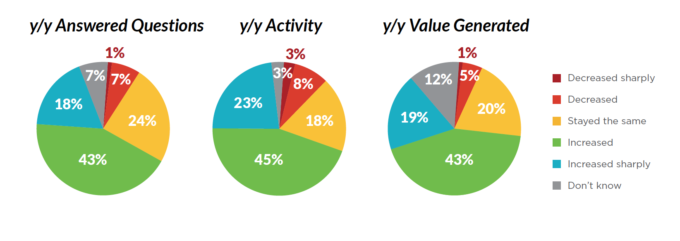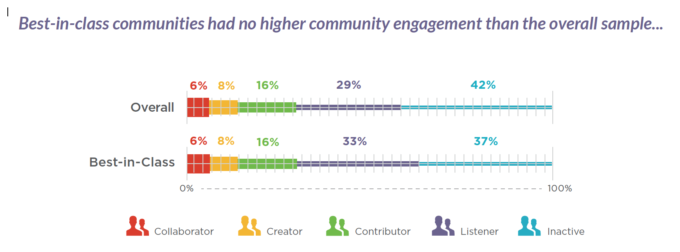Eight years ago, when Jim Storer and Rachel Happe founded The Community Roundtable, it was the beginning of understanding that the “art” of community management had a lot of science in it – repeatable best practices that can separate the best communities from the rest.
Each year since then, we have built The State of Community Management on a virtuous cycle. The report inspires discussions that raise new questions that shape the next report that inspires new discussions, and so on.
That brings us to today.
Toda y, we are pleased and excited to release The State of Community Management 2017 – the eighth annual report on the strategies, operations, artifacts and best practices of communities across organizations and use cases. Once again, we built upon the best of past surveys to surface new insights and information you can use as you think about your community. More than 300 community professionals shared their data with us – and we hope you’ll find the insights as interesting as compiling them was for us.
y, we are pleased and excited to release The State of Community Management 2017 – the eighth annual report on the strategies, operations, artifacts and best practices of communities across organizations and use cases. Once again, we built upon the best of past surveys to surface new insights and information you can use as you think about your community. More than 300 community professionals shared their data with us – and we hope you’ll find the insights as interesting as compiling them was for us.
The report is chock full of insights across the eight competencies of the Community Maturity Model, so rather than try to replicate them here, I just wanted to share two overarching trends and the key findings of this year’s research.
We’ll start with a great trend.
Trend: Optimistic perceptions foreshadow emerging success for community.
By a margin of nearly 10-to-1, respondents said their communities were delivering greater value than they were a year ago. Community professionals who took the survey also said by wide margins that more questions were being asked and answered, and that overall activity was higher. Those are the kind of insights that can spark greater investment, and respondents were three times as likely to say their budgets and staffing had grown than that they had shrunk during the course of the year.

The flip side, though, is that translating these optimistic feelings into measured results remains challenging.
Trend: Communities can demonstrate ROI – if they have the data.
Positive developments around community have piqued executive interest. But while some communities have captured measures of their value, too many aren’t getting at the right data to prove ROI. Just 9% of communities in the survey said they could calculate their own ROI – and a wide majority couldn’t get at critical community data such as answered questions or successful searches to get at their community ROI.
There are multiple reasons behind this shortcoming, not the least of which is a failure of platform vendors to make the metrics that capture community value easy to access and utilize. But community professionals can make a big move in the right direction by shifting their attention more to defining value and critical behaviors, and then translating those behaviors into more financial terms.

We’ll talk more about that in the coming weeks – but in short, good feelings have executives paying attention, but that attention will wane without real results, and soon.
Digging into the data further, we developed three key findings this year – in strategy, operations and tactics.
Strategy: Quality of engagement matters more than quantity as communities mature.
Our first key finding comes out of a surprising piece of data. This year, for the first time the engagement levels of our best-in-class communities was virtually the same as for our overall sample. In other words, in terms of quantity, best-in-class communities look just like their peers for engagement. We sliced and diced the communities by use case, size, etc., and found it was pretty consistent across all variables.

This is a trend we have seen over the past few years, and we see it as a fundamental shift in how more mature communities view success. Best-in-class communities are more likely to focus on metrics other than general engagement to gauge success – they pursue value metrics vs. vanity metrics. We’ve talked for years about how total activity is not a strong measure of success, any more than the loudest concert or most cacophonous discussion is the best one. You need to build engagement to a point, but after that point, it’s the quality of the connections that matters for community. Best-in-class communities outshine their peers on elements like executive engagement, advocate involvement and use of behavioral metrics such as answered questions. They also are more likely to say their communities were delivering answering more questions and delivering greater value than they were a year ago.
Your takeaway: Understand the elements that give communities real value – they’re the elements you want to focus on as your community matures.
Operations: Lasting behavior change requires more than transactional investments.
Our operations finding looks at what happens to communities in the middle of the maturity curve. Each year, we find a bottleneck of communities in trying to move from Stage 2 to Stage 3 in the Community Maturity Model. About 60 percent of communities in the survey for the past three years have scored in Stage 2, versus about 25 percent in Stage 3 or higher.
Why is this? It’s the nature of what leverages community maturity. Moving from a traditional hierarchical structure to an emerging community one is largely a function of investment. Organizations name a community manager, buy a platform, create content and maybe even write a strategy, and they can get to Stage 2.
Getting to the next stage requires something that can’t be done with a paid invoice, a hire or a planning group. It requires continuing efforts to enable community on an ongoing basis – by creating advocacy programs, developing and implementing roadmaps, securing budgets and delivering the shared value that the community brings to the organization and to community members. These are far more fundamental shifts in the day-to-day operations of the organization.
If you are a community manager looking to advance your community, it’s worth going through this list of elements that differentiate Stage 2 and Stage 3 communities and make them a core part of your long-term roadmap moving forward.
Your takeaway: Advocates, measurable shared value and a focus on desired behaviors will deliver real results for those who focus on the work needed to develop them.
Tactics: Connecting content and programs to strategy accelerates community success.
Lastly, we look at community tactics – and the two-headed monster of content and programs. We’ve talked about the importance of strong content and program elements in communities in past SOCMs, and that data holds true in 2017, too. But this year, we noticed something else interesting. Best-in-class communities didn’t produce more content or run more programs than their peers. However, best-in-class communities were far more likely to align their content and programming with their community and organizational strategies than their peers.

Once again – strategy trumps volume.
Your takeaway: Content and programs do drive engagement by giving members reasons to visit and opportunities to connect – but the communities that work best ensure that they are thoughtfully connecting those elements to community goals.
Taken together, these key findings suggest we are at an end of one chapter and beginning of the next in community management. Communities have generated engagement, created executive interest and become an accepted part of a lot of organizations. Now we must translate that engagement, interest, and acceptance into behavior change, understanding, and value and ROI.
We hope the State of Community Management 2017 report gets your wheels turning – and if you didn’t get a chance to take the SOCM survey and want to get your scores, you can do that, too!
We look forward to working with you to turn the engagement you have built into real, quantifiable value.
